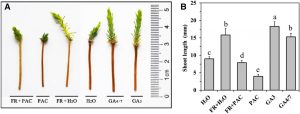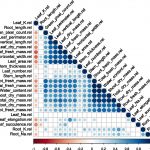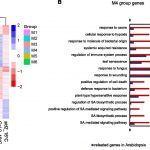Far-Red Light and Gibberellin Signaling in Pine
Shade-intolerant plants sense surrounding light competitors and respond rapidly with shade-avoidance responses (SARs), including elongation of the stem, hypocotyl, or petiole. Far-red light (FR) is known to be an important light cue during this process. Gibberellins (GAs) are known to play an important role in low red/far-red (R:FR) light ratio-mediated hypocotyl and petiole elongation in Arabidopsis (Arabidopsis thaliana). When compared with Arabidopsis and model crop species where considerable progress has been made in elucidating the molecular basis of the low R:FR response, details of the molecular mechanism underlying low R:FR-GA interactions in conifers remain poorly understood. Recently, transcriptome analysis has shown that the underlying mechanisms of shade avoidance may be diverse in gymnosperms in contrast with that in angiosperms. To fill this gap in our knowledge, Li et al. (10.1104/pp.19.00954) have explored the morphological and transcriptomic changes triggered by low R:FR, GA, and paclobutrazol (PAC), a GA biosynthesis inhibitor, in Pinus tabuliformis seedlings. To account for errors caused by slow growth and the physiological response to light in conifers, the authors analyzed shoots for an extended time (>100 d) rather than using a hypocotyl model system for 1 week. Transcriptome profiles revealed that low R:FR conditions and GAs have a common set of transcriptional targets in P. tabuliformis. Evidence is presented that the effect of low R:FR on shoot elongation in P. tabuliformis is at least partially modulated by GA accumulation, which can be largely attenuated by PAC. GAs are also involved in the cross talk between different phytohormones in the low R:FR response. A key gene in GA biosynthesis, PtKAO2, which encodes ent-kaurenoic acid oxidase (KAO), was strongly stimulated by low R:FR without being affected by GA feedback regulation or the photoperiod. These results show that GA signaling is required in conifers for FR-induced shoot elongation and increases our understanding of the connection between FR and GAs in plants.
stem, hypocotyl, or petiole. Far-red light (FR) is known to be an important light cue during this process. Gibberellins (GAs) are known to play an important role in low red/far-red (R:FR) light ratio-mediated hypocotyl and petiole elongation in Arabidopsis (Arabidopsis thaliana). When compared with Arabidopsis and model crop species where considerable progress has been made in elucidating the molecular basis of the low R:FR response, details of the molecular mechanism underlying low R:FR-GA interactions in conifers remain poorly understood. Recently, transcriptome analysis has shown that the underlying mechanisms of shade avoidance may be diverse in gymnosperms in contrast with that in angiosperms. To fill this gap in our knowledge, Li et al. (10.1104/pp.19.00954) have explored the morphological and transcriptomic changes triggered by low R:FR, GA, and paclobutrazol (PAC), a GA biosynthesis inhibitor, in Pinus tabuliformis seedlings. To account for errors caused by slow growth and the physiological response to light in conifers, the authors analyzed shoots for an extended time (>100 d) rather than using a hypocotyl model system for 1 week. Transcriptome profiles revealed that low R:FR conditions and GAs have a common set of transcriptional targets in P. tabuliformis. Evidence is presented that the effect of low R:FR on shoot elongation in P. tabuliformis is at least partially modulated by GA accumulation, which can be largely attenuated by PAC. GAs are also involved in the cross talk between different phytohormones in the low R:FR response. A key gene in GA biosynthesis, PtKAO2, which encodes ent-kaurenoic acid oxidase (KAO), was strongly stimulated by low R:FR without being affected by GA feedback regulation or the photoperiod. These results show that GA signaling is required in conifers for FR-induced shoot elongation and increases our understanding of the connection between FR and GAs in plants.



